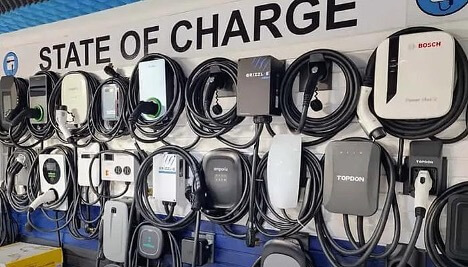Innovation at Grid’s Edge Improves EV Charging at Home
When thinking of buying an electric vehicle, drivers often find the installation of charging equipment at their homes to be daunting – the complexity can prevent them from buying an electric vehicle of any kind. Now, two companies are developing a customer-focused pilot to test and manage EV charging loads in real time, saving customers time and money.
You’ve had a long, hard day at the office, the shop, the factory. Traffic was slow, but you finally made it home, enjoying the drive in your new electric car. Then you remember – this is the day the EV charger was to be installed in your garage. But your spouse says the electrician couldn’t come; you’ll have to charge up at work or at a public EV charging station.
When thinking of buying an electric vehicle, drivers often find the installation of charging equipment at their homes to be daunting – the complexity of technology and regulations can prevent them from buying an electric vehicle of any kind. For renters and residents of multi-unit apartment buildings it can prove even more difficult.
Earlier this year, an August 2024 survey by the U.S. National Multifamily Housing Council showed that 83 percent of EV owners prefer to charge at home, but finding the right equipment and professional help as well as the solving the technical and regulatory challenges can keep many a potential buyer away from EVs altogether.
Now, to offer a cost-effective, consumer-friendly, secure end-to-end solution that increases access to electric vehicle charging at home, Pacific Gas and Electric Company (PG&E) is working on an innovative program to make electric vehicle charging more accessible and affordable for PG&E customers.
PG&E, which serves some 16 million people in northern and central California, is developing faster, less costly EV charging at home with Itron, Inc., a Washington State company that offers electricity, gas, water and thermal energy measurement devices and control technology, communications systems and software, as well as management and consulting services.
“IN COLLABORATION WITH ITRON AND OUR EV SOLUTION PROVIDERS, PG&E IS WORKING TO GIVE MORE OF OUR CUSTOMERS ACCESS TO FASTER CHARGING AT HOME THROUGH A SAFE AND AFFORDABLE ALTERNATIVE TO PANEL AND SERVICE UPGRADES. THIS SOLUTION MAKES EV ADOPTION EASIER BECAUSE CUSTOMERS CAN AVOID OUT-OF-POCKET EXPENSES AND GET FASTER LEVEL 2 EV CHARGING IMMEDIATELY, WHILE KEEPING VEHICLE CHARGING WITHIN SAFE GRID LIMITS.” –Mike Delaney, Vice President, Utility Partnerships and Innovation, Pacific Gas & Electric Company
Itron is collaborating with PG&E to make electric vehicle charging more accessible and affordable for the utility’s customers. The two companies share the goal of lowering the barriers for customers to charge their EVs at home by avoiding the need for costly customer electric panel and service upgrades.
Itron and PG&E are developing a customer-focused pilot to test and manage EV charging loads in real time. Their plan of action combines elements of consumer engagement, advanced edge compute capabilities, and broad industry collaboration.
Advanced edge computing capabilities cover complex data processing – real-time analytics, AI inferencing and machine learning, directly at the source of data generation, in EV charging stations in buildings at the edge of the grid.
“Grid edge” is a new term that covers all distributed hardware, software and business innovations that exist close to the end users, rather than at the center of a traditional electricity generation network.
Distributed energy resources (DERs) at the edges of the electricity grid can include renewable energy technologies like solar panels on the roof of a residence, energy storage in batteries, and combined heat and power facilities.
DERs can help agencies meet goals and mandates, deliver cost and energy savings, and provide environmental benefits. With powerful edge computing hardware and optimized software designed for distributed environments, they can meet data security and privacy requirements.
Here’s how it works. Typically, a Level 2 EV charger requires a 200-amp service to the customer’s home.
A Level 2 charger is up to 15 times faster than plugging an EV into a standard wall outlet and allows drivers to fully charge their EVs from empty overnight.
If a customer has 100-amp service, which is the case for about half of the homes in PG&E’s service area, upgrading to a 200-amp panel and service can cost customers thousands of dollars and take months to complete, the company says.
Unlike typical cloud-only software-based integrations that exchange information only a few times a day, the EV Connect program is unique in that it will use distributed intelligence edge computing that operates on a customer’s electric meter directly.
This on-meter application connects to, and coordinates with, the customer’s EV charger to keep charging within their panel and utility grid limits.
The combined solution enables a customer to avoid the cost of panel and service upgrades while still being able to install and operate faster Level 2 EV charging at home.
“The EV Connect collaboration with our longtime customer, PG&E, illustrates the possibilities of Itron’s Grid Edge Intelligence portfolio. The utility can deploy additional capabilities to its existing Itron communications network to enable intelligence at the grid edge and help end-use customers avoid the financial burden and wait time associated with upgrading service panels and residential service conductors,” said Don Reeves, senior vice president of outcomes at Itron.
“This is just one example of the possibilities for distributed energy resource management enabled by Itron’s technology platform,” Reeves said. “By deploying grid edge intelligence, we can help consumers and utilities avoid costly upgrades whatever the source of the demand, such as thermostats, water heaters, appliances, pool pumps, photovoltaic inverters and more.”
Starting Small, Rapid Growth Is Expected
The initial scope of the EV Connect pilot program will support up to 1,000 residential customers who now own or are considering buying an EV and have panel or service limitations that prevent them from installing a Level 2 EV charger at home.
PG&E will replace customers’ existing electric SmartMeters™ with Itron Riva meters, enabling them to immediately install and utilize Level 2 chargers available within the program.
PG&E and Itron plan to launch the new pilot offering in early 2025, with wider availability in the second half of 2025.
Depending on the success of the pilot program, PG&E will evaluate extending the program to be broadly available on an ongoing basis.
Itron demonstrated the EV Connect application publicly for the first time at PG&E’s 2024 Innovation Summit on November 13, 2024, in San Jose, California.
“The shift to electric vehicles is no longer a question of if but when,” acknowledges the EV website Cyber Switching. “For city leaders, the choice is clear: investing in EV charging infrastructure is essential to future-proofing cities.”
“This infrastructure supports environmental goals, boosts economic growth, enhances accessibility, and improves quality of life for residents. The benefits of EV infrastructure extend far beyond the individual EV owner, touching every aspect of urban life,” Cyber Switching posted.
“As we look to the future, cities that embrace EV technology will be better positioned to thrive in a rapidly changing world. By preparing for the electric vehicle revolution, city leaders can ensure that their cities remain vibrant, competitive, and sustainable for generations to come,” Cyber Switching declared. “The time to act is now, and investing in EV charging is a key step toward a cleaner, more resilient urban future.”
Sources: Statements from: Mike Delaney and Don Reeves, and additional material from the U.S. Dept. of Energy, Federal Energy Management Program, National Multifamily Housing Council, Pacific Gas and Electric Company, Itron, Cyber Switching
Tags: electric vehicles, EV, EVs, EV charging, home charging, Level 2 charging, California, Pacific Gas and Electric, Itron, grid edge, distributed energy
By Sunny Lewis, journalist, founder of Environment News Service (ENS) at: ens-newswire.com, and expert in the field of sustainable mobility in the United States and around the Pacific Rim.
Toute l’actualité de Movin’On
dans votre boîte mail
Auteur
Partager
Tweets de @movinonconnect
Movin'On 2035 TODAY EP02 - Circular Economy & Competitivity
Movin’On 2035 TODAY EP01 – Fair Mobility for All https://x.com/i/broadcasts/1yNxagBrWZbGj
✨ THAT'S A WRAP!
Movin'On Summit 2024 has just concluded in Brussels!
More than 350 leaders and experts in sustainable mobility gathered to exchange ideas, collaborate, and share their vision for desirable and decarbonised mobility in Europe. Together, we explored ways to build…
🔴 Live from #MovinOnSummit2024
@AshaSumputh has just invited Denis Machuel, CEO at @AdeccoGroup and Florent Menegaux, President of the @Michelin Group & President of Movin'On
L’actualité de la mobilité durable
Découvrez les dernières tendances, des analyses thématiques et nos prochains rendez-vous







